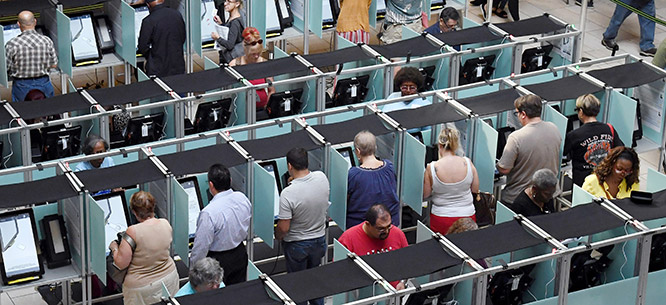It’s the Electoral Infrastructure, Stupid
It’s the Electoral Infrastructure, Stupid

Choose your metaphor for the Democrats’ quandaries. Circular firing squad? Refighting 2016? Or 1972? We latch on to a surfeit of speculation mixed with a few shreds of evidence. Acrimony seeks a vacuum. Anxiety is the mother of metaphors. How easily, or desperately, we are seduced into passionate cheers and revulsions!
So what do we know? Finally, a handful of voters from Iowa and New Hampshire have expressed their preferences. Their choices will bear on the coming primaries and the delegate count—or they won’t so much. Known unknowns pile high. As much as we in our anxiety would like to latch onto prognostications, we’re going to have to shoulder a ton of uncertainty for months.
But whoever your favorite or least favorite candidate, of two things we can be confident. One concerns the past: Revulsion against Donald Trump mightily helped sway Democratic victories in 2018. The 49.3 percent turnout in 2018 was, according to Vox, “the highest [midterm] voter turnout percentage since 1914, when 50.4 percent of eligible voters went to the polls.” Beyond the noise of everyday politics, remember that Donald Trump’s approval rating average have yet to break 45 percent.
The second concerns the present and future: At this stage in the campaign, the single most important thing to do is to register voters in swing states. This is the deep politics of the hour. Parachuting in at the last minute will not avail. Politics, in the end, takes place on the ground. The Republicans are not twiddling their thumbs.
A number of efforts are raising money to funnel into on-the-ground organizing, particularly in swing states. I can’t claim to be an expert on all of them, but after checking with old friends whose organizing credentials go back decades, I’ve put my fundraising efforts behind the Movement Voter Project (MVP). This tightly run network of experienced organizers funds local groups in Wisconsin, Michigan, Pennsylvania, Florida, and Arizona. “While the Democrats obsess over the primary,” the MVP notes, the GOP is focused on those Big Five. Their logic is unimpeachable: Don’t wait till the summer or fall to drop into swing states. “We need to invest now in local groups in these Big Five states. They know how to organize their own communities. But they need our support today to lay the groundwork to win in November.”
Their website lists the groups they fund. All donations are funneled directly to local organizations. Choose your preferred state or your constituency. Funding the organizations who will register voters and turn them out is essential to victory.
There’s also Swing Left, which has garnered celebrity support and embraces what they call a “Super State Strategy.” Through the coming summer, the money they raise is spread among state legislature races, thinking ahead to gerrymandering fights that will shape the House for years to come.
Infrequent voters will matter. Depressed and disgusted voters will matter. Even where Republican vote suppression is rampant, as in Wisconsin, where in December a judge threw 234,000 voters off the rolls, it can be fought. How many times must it be repeated that Trump won Wisconsin by 22,177 votes, in a state where Jill Stein picked up 31,072?
In 2016, according to Wisconsin’s Democratic Party chair Ben Wikler, a MoveOn veteran, the undernourished state party waited till the fall to start organizing. Hillary Clinton didn’t campaign there—and her appeal to black voters was unimpressive, thanks partly to targeted Russian Facebook ads—but worst of all, the ground game was paltry. As Joshua Darr wrote in Vox, “In Milwaukee County, the largest source of Democratic votes in the state, Clinton opened only four offices compared to Obama’s 10 [in 2012]. Dane County, home to Madison, received only three offices, compared to seven from Obama.” In contrast, Wikler’s Democrats aim to re-register disenfranchised voters and have been organizing what he calls “relational organizing,”on the principle that “the most effective messengers are the most familiar messengers.”
Even if you’re inclined to agree with informed observers that the overwhelming majority of registered or likely voters are entrenched in their preferences, the 2020 vote is swingable. According to one survey cited by the New York Times’s Nate Cohn, swing voters “represent 15 percent of the electorate in the battleground states, and they say there’s a chance they’ll vote for either Mr. Trump or the Democrat.” The shrewd Ed Kilgore writes in New York:
The genuine “undecided” vote is only 8 percent—a number which, historically, is likely to go down as we near the general election. And of the 22 percent who are leaners, 14 percent are not “swinging” between the two major parties, but swinging between voting for one of those parties, voting for a minor party, or staying home.
Of undecided voters who are predisposed toward a party, Democrats hold a significant advantage. They need to be registered, then mobilized.
Yet another estimate, by FiveThirtyEight’s Geoffrey Skelley, finds that “even if there is evidence that the overall number of swing voters is declining, we’re still talking about at least a tenth of the electorate who might be willing to switch parties — and the fact that they broke for Trump in 2016 mattered.”
Insert here, reader, your list of what is at stake in 2020. Talk about judges. Talk about climate. Talk about immigrants. Talk about inequality. Talk about everyday decency. Whichever candidate faces the grotesque incumbent, this race can be swung. But it won’t swing by itself.
Todd Gitlin is a professor of journalism and sociology and chair of the PhD Program in Communications at Columbia University. He is a member of the Dissent editorial board.






